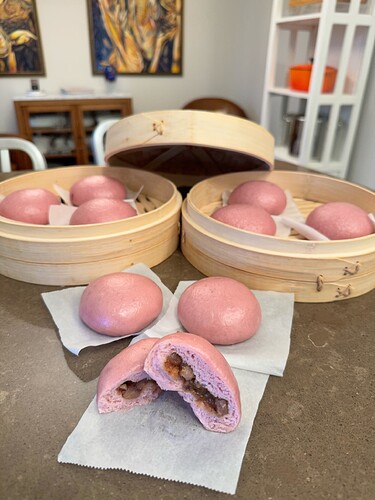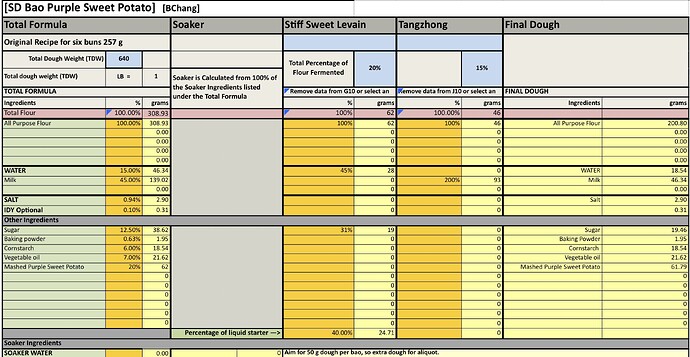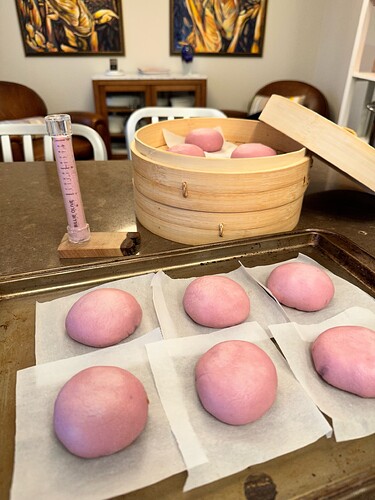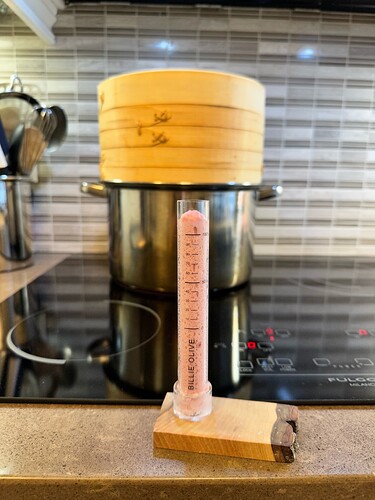Being back in Toronto I have access to ingredients that I couldn’t find in Fort Lauderdale Florida. Yesterday I went to Chinatown and picked up some purple sweet potatoes and some BBQ Pork. I’ve been wanting to try making fully sourdough (not hybrid with IDY) Baozi for a while, the last attempt at it didn’t go well. Given the expense of buying BBQ Pork these needed to be successful and they were.
The dough is quite stiff as is customary with these steamed buns so mixing my hand and kneading on the countertop are the way to go. The dough comes together very quickly. Because there is baking powder in these, the pH data is interesting. Not surprisingly they start out with a high pH of 5.62 and at the time of steaming only dropped to 4.86. Even the delta of only 0.76 is very low. Some of that is definitely the baking powder but I also used a stiff sweet starter as well. This kind of bread shouldn’t have a sour tang and these definitely did not. In the future, I would increase the dough per baozi to 60-65 so I can get more filling into each. As well, I would increase the final proof even more, these were steamed at 112% of rise for the second batch, I’d say I can go up incrementally to 120-125% next time as the dough performed well.
I did not use the optional IDY in this bake.
For 12 Baozi
Make the Filling
Filling Ingredients
- 4 tablespoons chicken stock
- 2 tablespoons hoisin sauce
- 1 tablespoon [oyster sauce]
- 1 tablespoon sugar
- 1 tablespoon [Shaoxing wine](or dry sherry)
- 1 clove garlic , grated
- 1/8 teaspoon [five spice powder]
- 2 tablespoons cornstarch
- 1 heaping cup (180 g / 6.5 oz) [homemade char siu], diced (or store-bought char siu) 1.5 cups is better
- While the dough is resting, combine all the filling ingredients in a small pot except for the diced char siu. Mix until the cornstarch is dissolved fully.
- Bring the mixture to a boil and cook until thickened, so you can draw a line on the bottom of the pot with a spatula, about 1 minute. Take the pot off the heat and let the mixture cool off. Once cooled, add the diced char siu and mix until it is evenly distributed.
Overnight Levain
In a large jar, combine all purpose flour, water, ripe sourdough starter, and sugar. Cover the jar loosely and let the levain ripen overnight at warm room temperature (I keep mine around 76°F to 78°F).
Tangzhong
In a sauce pan set on med heat with about 1.5 cm of water, place the bowl of your stand mixer creating a Bain Marie, whisk the milk and flour until blended. Then cook for several minutes until thickened, stirring regularly with a spoon or heat-resistant spatula. Let cool.
In The Morning
In a mixing bowl, add the Tangzhong, water, milk, sugar and salt, mix to dissolve. Add the stiff sweet levain and using a silicone spatula, cut the levain into small pieces. Add the baking powder, cornstarch, oil and flour. Mix to form a shaggy dough. Allow to rest for 10 mins. On your countertop knead the dough until good gluten development, this is a very stiff dough so I prefer to knead it manually to spare my mixer. Spread about half of the mashed sweet potato on top of the flatten dough, fold and then repeat with the remaining mashed potato. Knead the dough on the countertop until the mashed potatoes are well distributed. Remove some dough for aliquot jar to follow rise. Shape into a boule and rest in a covered bowl at 82°F until the dough has increased by 40%.
Prepare twelve 4” parchment squares.
Remove the dough to the counter and divide into 12 equal portions shaping each into a tight boule. Allow to rest for 10 mins. Roll out the dough into a 5” circle thickest at the center rolling towards the center of the circle. Flour the back of the dough circle then place about 45 g of bbq pork filling in the center. Form into a bun pleating the dough together at the top. Place on a 4-inch square of parchment paper.
Cover the filled bao with a damp cloth and place in a warm place and allow them to ferment until they pass the poke test. Using an aliquot jar they should reach about 100% rise.
Prepare your steamer setup and bring water to a boil. Working in batches if necessary, arrange buns in the bamboo steamer spacing 2” apart. Once the water is boiling turn the heat down to medium. Steam over boiling water for 10 minutes. Turn off the heat and leave the buns in the covered steamer for 5 more minutes to prevent collapsing. (I left them in the steamer and on the same stove element turned off). Do not lift the lid of the steamer, doing so will cause a sudden drop in temperature that can cause the buns to collapse or wrinkle or dent. Remove the buns from the steamer and allow them to cool for 5 minutes before serving.
Buns can be kept in an airtight container (a resealable bag works great) at room temperature for up to 4 days or in the freezer for up to 3 months. Room temperature buns can be reheated in the microwave for 15 to 20 seconds or steamed for about 2 minutes, until soft and warmed through. Reheat frozen buns by steaming until soft and warmed through, 10 to 15 minutes.
For those interested, the aliquot jar shown in the photos is made by Billie Olive and it is well designed and easy to use. I have always found using one helpful when adjusting my bakes when repeating a bread and wanting to increase or decrease the degree of fermentation.
I am doing a giveaway with Billie Olive for one of these aliquot jars on Instagram this weekend. If you’re interested head over to Instagram and follow me bread_md and you’ll be able to enter the free giveaway for the aliquot jar. I will be posting the giveaway tomorrow and it will only be open for a short while.






